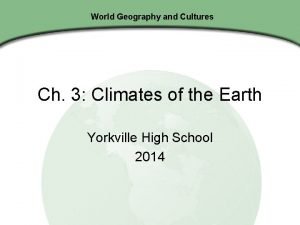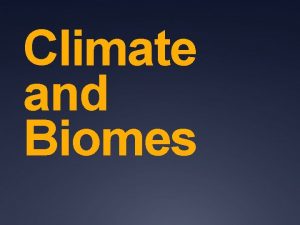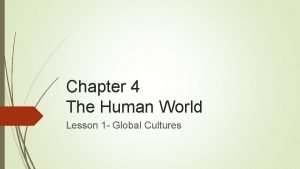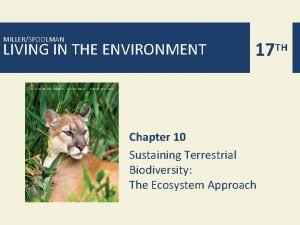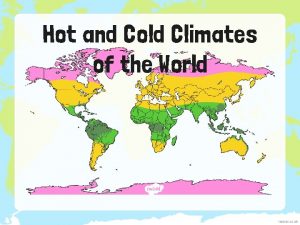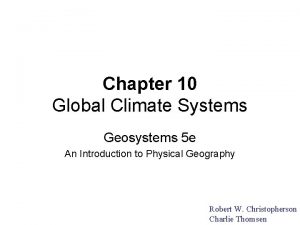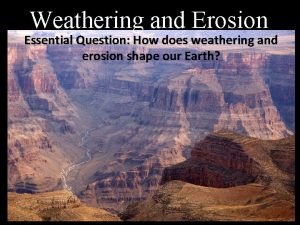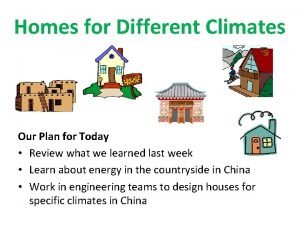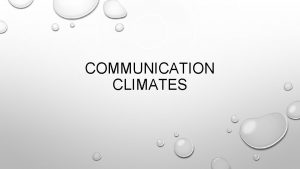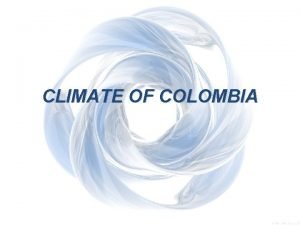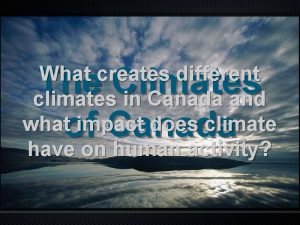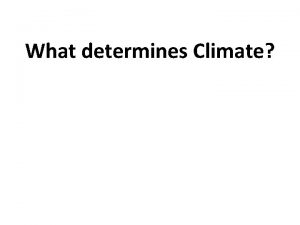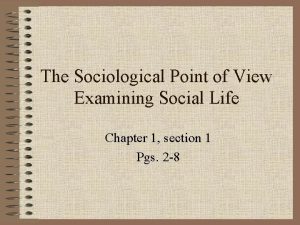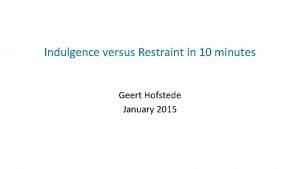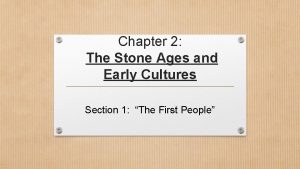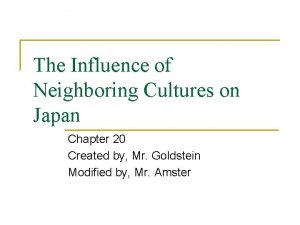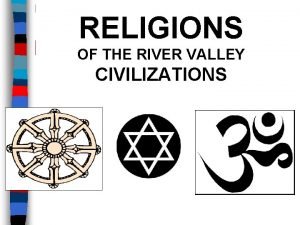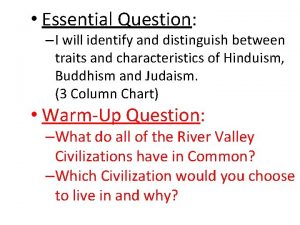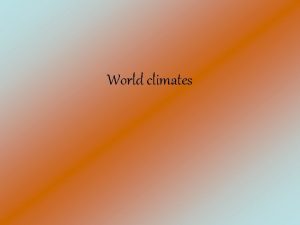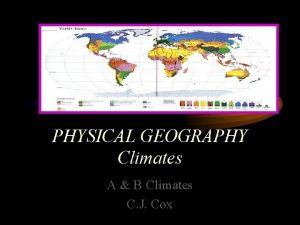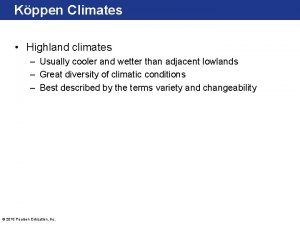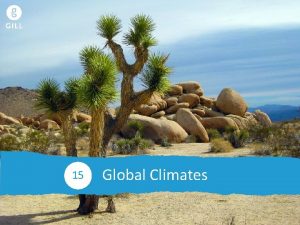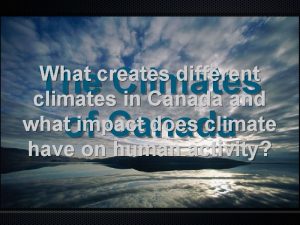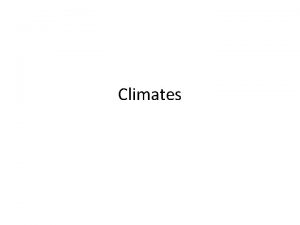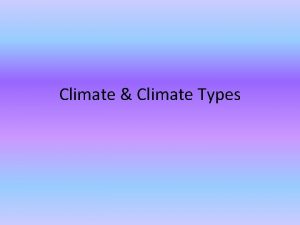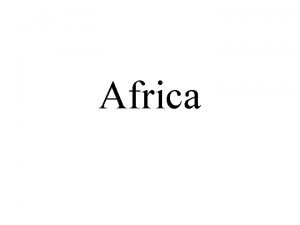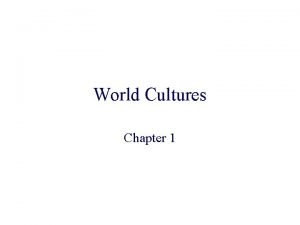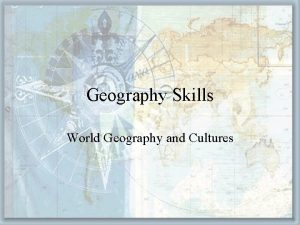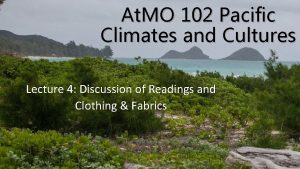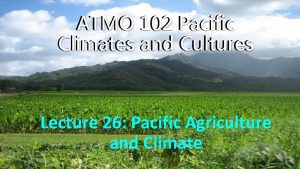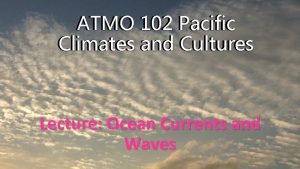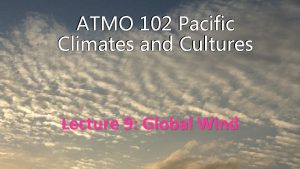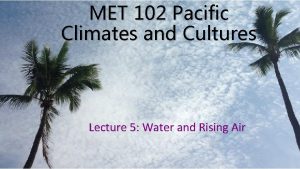World Geography and Cultures Ch 3 Climates of









































- Slides: 41

World Geography and Cultures Ch. 3: Climates of the Earth Yorkville High School 2014

Ch. 3 Section Break-Down • Section 1: Earth-Sun Relationships • Section 2: Factors Affecting Climate • Section 3: World Climate Patterns

Think About It… – Where is it nighttime right now? – What time is it in California, Hawaii, Japan, Afghanistan?

3. 1 Earth-Sun Relationships • Essential Question: Explain how the Earth’s position (in space) in relation to the Sun affect life on Earth?

Climate and Weather v. Climate Weather = short term – Think: I should bring my umbrella, it might rain today. Climate = long term – Think consistently rainy in Seattle, I always need my umbrella. …cold snowy winters in Chicago


Earth’s Tilt and Rotation • Axis – determines how much direct sunlight the Earth receives at a given point – Temperature • Fahrenheit v. Celsius – Rotation – 1 every 24 hours

Earth’s Revolution • Revolution – One trip around the sun – 365 ¼ days – Seasons - reversed north and south of the Equator • • Spring Equinox – March 21 Summer Solstice – June 21 Fall Equinox – September 23 Winter Solstice – December 22 – The Poles • North – Midnight sun • Rotation – one 24 hour period (day)

24 hour sunlight in Alaska

The Greenhouse Effect • Earth’s atmosphere traps the sun’s heat and energy and keeps it from escaping back into space. – w/o = too cold to live for most – 50% of Sun’s radiation • Global Warming – Rise in temps – Cause- burning of coal, oil, natural gas • Releases CO 2 – Potential problems? ? ?


Greenhouse effect with Global Warming

3. 2 Factors Affecting Climate • Essential Question: What factors can affect how climates are distributed on Earth’s surface? • Think about… – Why are Chicago Winters usually so cold and snowy but summers extremely hot? – Antarctica…would you go there? He’s there …→

Latitude, Elevation and Climate • Low Latitudes – Between 30°South and 30°North – Tropic of Capricorn, Equator, Tropic of Cancer are in this zone …sun all year = Warm to hot • High Latitudes – Between 60°North and 90°North and between 60°South and 90°South – Arctic/Antarctic circle- direct sunlight 180 days

Latitudes, Elevation and Climate • Midlatitudes – Between 30° North and 60° North and 30° South and 60° South – Varying weather – Temperate Climate – dramatic seasonal changes

Latitudes, Elevation and Climate • Elevation – Influence Temp regardless of latitude – Thinner air retains less heat SEE chart on page 55


Winds and Ocean Currents • Wind Patterns – Happen because of Temp differences – Tropical winds towards poles and vice versa – Prevailing winds – Coriolis Effect • Trade winds • Westerlies • Polar Easterlies

Winds and Ocean Currents • Horse Latitudes – At the Equator – little wind • Doldrums • Ocean Currents – Warm and cold streams of water • Causes – rotation, air pressure, water temps

Distributing the Sun’s Heat

Winds and Oceans Currents • Weather and the water cycle – How does the water cycle cool or change the weather (think back to chapter 2) • El Nino – Periodic change in ocean currents, water temps and weather in mid-pacific region – Appears infrequently – So what happens?

Landforms and Climate • How do physical features affect climate? – Water – Coasts – Mountains • Windward • Leeward • Rain Shadow


World Climate Patterns • Essential Question: How do Geographers classify Earth’s climate and vegetation?

Climate Regions • • • Tropical Dry Midlatitudes High latitude Highland – Soils and Vegetation


Climate Regions • Tropical Climates – Low Latitudes – Tropical Areas • Tropical wet – Hot and Wet throughout the year (80 Degrees) – Daily Rain (80 in) » Ex. Amazon River Basin • Tropical dry – Dry winters, wet summers (Hot) – Fewer trees (Not lush) » Ex. Parts of Africa, central and south America, Australia

Amazon River Basin

Savannah in Austraila

Climate Regions • Dry Climates – Desert • • Dry areas Sparse plant life Less than 10 in of rain Scrub, cactus, plants…oasis? – Ex. Sahara – Steppe • Border deserts • Largely treeless grasslands • 10 -20 in rain per year – Ex. Eastern Europe and western and central Asia

Sahara Desert


Climate Regions • Midlatitude Climates – 4 regions • • Marine West Coast Mediterranean Humid subtropical Humid Continental

Climate Regions - Midlatitude • Marine West Coast – Cool summers – Cool damp winters – Lots of rain • Coniferous - evergreens • Deciduous – broad leaves, change colors, lose leaves in winter • Ex. Pacific coast of North America

Climate Regions - Midlat • Mediterranean – Mild rainy winters – Hot sunny summers – Woody bushes, short trees

Climate Regions – Mid lat • Humid Subtropical – Short mild winters – Year round rain – High humidity – Prairies, inland grasslands, evergreens and deciduous trees • EX. Southeastern US

Climate Regions – Mid Lat • Humid Continental – Inland location (Ocean…little impact) – North = long and severe snowy winters, shorter cooler summers – More evergreens • Ex. Much of the Very north, Northern Hemisphere.

Climate Regions • High Latitude Climates – Freezing Temperatures • Lack of direct sunlight • Vegetation limited – Subarctic • North of arctic circle – bitter winters, short cool summers • Permafrost – Tundra – near the poles • Indirect sun, vegetation limited, snow and ice • Highland Climates – High elevation, mixed forests…


Climate Changes • Ice ages – over 2 million years • HEI – – Fuels, acid rain, deforestation, smog, changes in water flows

Up Next: • The Human World – World Population – Global Cultures – Political and Economic Systems – Resources, trade and the environment
 Chapter 3 climates of the earth answers
Chapter 3 climates of the earth answers Organizational cultures often reflect national culture.
Organizational cultures often reflect national culture. Different climates around the world
Different climates around the world Climates of earth lesson 1 answer key
Climates of earth lesson 1 answer key Guided reading activity the human world
Guided reading activity the human world Unfenced grasslands in tropical and temperate climates
Unfenced grasslands in tropical and temperate climates Hot and cold world map
Hot and cold world map How many major climate types are there worldwide brainpop
How many major climate types are there worldwide brainpop Explain how köppen’s climate system classified climates.
Explain how köppen’s climate system classified climates. Weathering
Weathering Houses in different climates
Houses in different climates Types of communication climate
Types of communication climate Where is colombia located?
Where is colombia located? Climates in france
Climates in france Different climates in canada
Different climates in canada The three kinds of temperate marine climates all have
The three kinds of temperate marine climates all have What is sociology perspective
What is sociology perspective Recreational activities across cultures and genders
Recreational activities across cultures and genders Chapter 20:11 using reagent strips to test urine
Chapter 20:11 using reagent strips to test urine Indulgence and restraint culture examples
Indulgence and restraint culture examples Southeastern and gulf cultures
Southeastern and gulf cultures What aspects of minoan culture did the mycenaeans adopt
What aspects of minoan culture did the mycenaeans adopt Cultures and organizations software of the mind
Cultures and organizations software of the mind Tandem language
Tandem language The stone ages and early cultures
The stone ages and early cultures Ap human geography frqs
Ap human geography frqs 5 themes of geography ap human geography
5 themes of geography ap human geography Stateless nation
Stateless nation World geography spring final review
World geography spring final review World geography chapter 3 weather and climate
World geography chapter 3 weather and climate Sub cultures
Sub cultures Which cultures believe in reincarnation
Which cultures believe in reincarnation The influence of neighboring cultures on japan test
The influence of neighboring cultures on japan test 5 major world religions and their founders
5 major world religions and their founders Which cultures believe in reincarnation
Which cultures believe in reincarnation Religion
Religion Adrian holliday small cultures
Adrian holliday small cultures Taste different cultures
Taste different cultures Types of cultures
Types of cultures Individualistic culture vs. collectivist culture
Individualistic culture vs. collectivist culture Collectivistic cultures
Collectivistic cultures Which cultures believe in reincarnation
Which cultures believe in reincarnation
